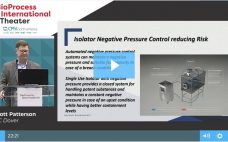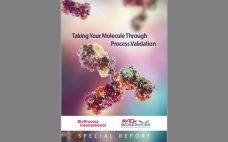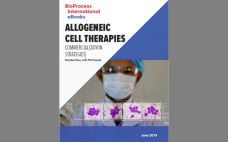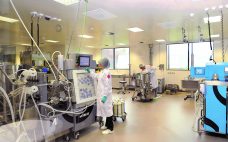Scott Patterson, vice president of commercial sales, ILC Dover Antibody–drug conjugates (ADCs) are increasing in popularity, with a robust pipeline that could lead to a US$10-billion market over the next several years. These novel treatments combine the high potency of small molecules with the targeting ability of monoclonal antibodies (MAbs). However, the challenge of such treatments is that they combine a highly potent, toxic material with a large protein that will target a treatment area. As a result, manufacturing the…
2019
Immunotherapy: Taking Aim at Solid Cancers
As cell and gene therapies arrive on the market, all eyes have focused on autologous chimeric antigen receptor (CAR) T – cell therapies. At the 2019 Phacilitate Leaders World and Stem Cell Summit in Miami, FL, delegates looked at where the biopharmaceutical industry is going in the cellular immunotherapy space. Whether for off-the-shelf CAR T-cell products, personalized cancer vaccines, or modified natural killer (NK) cells derived from human induced pluripotent stem cells (iPSCs) — cell and gene therapy development is…
Supply Chain Solutions for Cell and Gene Therapy Companies
Stakeholders across the supply chain stress that quality of starting material will be key to the success of cell and gene therapies. This is a topic that has created issues in the past, is puzzling the industry presently, and is likely to cause more problems going forward. This topic was front and center at the 2019 Phacilitate Leaders World and World Stem Cell Summit in Miami FL, with presentations focusing on supply chain solutions to address these complex challenges; cell…
Automation in Cell and Gene Therapy Development
The US approvals of chimeric antigen receptor (CAR) T-Cell therapies Kymriah (tisagenlecleucel) and Yescarta (axicabtagene ciloleucel) and gene therapy Luxturna (voretigene neparvovec) in 2017 heralded a “new frontier of medicine.” But with great innovation comes great costs and criticism (such as the Kymriah’s US$475,000 price tag). Many companies argue that these one-off therapies represent good value for patients and payers compared with traditional treatments, however, no matter your perspective, the COGs picture for cell and gene therapies isn’t good and…
Manufacturing of Cell and Gene Therapies
The peak of demand for curative cell and gene therapies will be unlike that of traditional drugs and thus could cause forecasting and overcapacity issues going forward. Predicting the future is always difficult, and poor decisions can be costly and highly damaging for a company. At the 2019 Phacilitate Leaders World and Stem Cell Summit in Miami, FL, several presentations and conversations focused on the forecasting dilemma and how manufacturing needs innovation, just to name two. This eBook details these…
Taking Your Molecule Through Process Validation
The dynamics of the biopharmaceutical industry to get innovative products to the client has evolved over the years. Studies have shown that by 2021, biologics and biosimilar products are projected to have higher growth than other pharmaceutical products. Following the industry trend, Avid Bioservices as a Contract Development Manufacturing Organization (CDMO) has helped numerous clients complete their process validations campaigns. Between 2016 to 2019, Avid has successfully completed six. This custom report will share some key factors to consider for…
eBook: Allogeneic Cell Therapies Commercialization Strategies
Manufacturers of allogeneic cell therapies face development and commercialization challenges unlike those of traditional cell therapies. In a discussion with Phil Vanek of GE Healthcare, we outline several of the key challenges of processing these products and bringing them to market. Approaches for reducing development costs and lowering pricing are highlighted, and a separate analysis presents three pricing models specific for allogeneic “off the shelf” cell products.
Biopharmaceutical Characterization, Part 2: Applications and Strategies for Diverse Products — A Conference Report
Last fall, KNect365 brought together more than 250 analytical specialists to discuss biological assays and characterization of well-characterized biologics in Rockville, MD. Speakers from the US Food and Drug Administration joined experts from leading biopharmaceutical companies, service providers, and consultancies for case studies, regulatory interactions, sharing perspectives, and learning about emerging technologies. Part 1 of this report in January 2019 focused on the bioassay section of the meeting. Here in Part 2 sponsored by Sartorius, BPI’s senior technical editor reports…
Large-Scale Capacity Strategies: Single Use, Multiuse, or Both?
Early manufacturing facilities for large-scale production of biopharmaceuticals were, by necessity, very large. Low expression titers and blockbuster-market products such as monoclonal antibodies (MAbs) combined to require massive bioreactors — with capacities of 10,000– 20,000 L or more — and supporting infrastructure. In my early days covering the industry, I visited a few such facilities and was always awed by the huge tanks and what seemed like miles of piping. A 2010 Pharmaceutical Engineering article described a process modeling approach…
Continuous Biomanufacturing: A New Approach to Process Scale
The BioPhorum first-edition Technology Roadmap outlined a 10-year vision for therapeutic protein production in the biopharmaceutical industry (1). The roadmap describes multiple manufacturing scenarios ranging from large-scale (~20,000-L production) to small and agile, portable production facilities. It includes detailed analyses of the needs for the future in each of the following areas: Process technologies (2) Inline monitoring and real-time release (3) Automated facilities (4) Modular and mobile (5) Knowledge management (6) Supply partnership management (7). Since the 2017 publication of…










